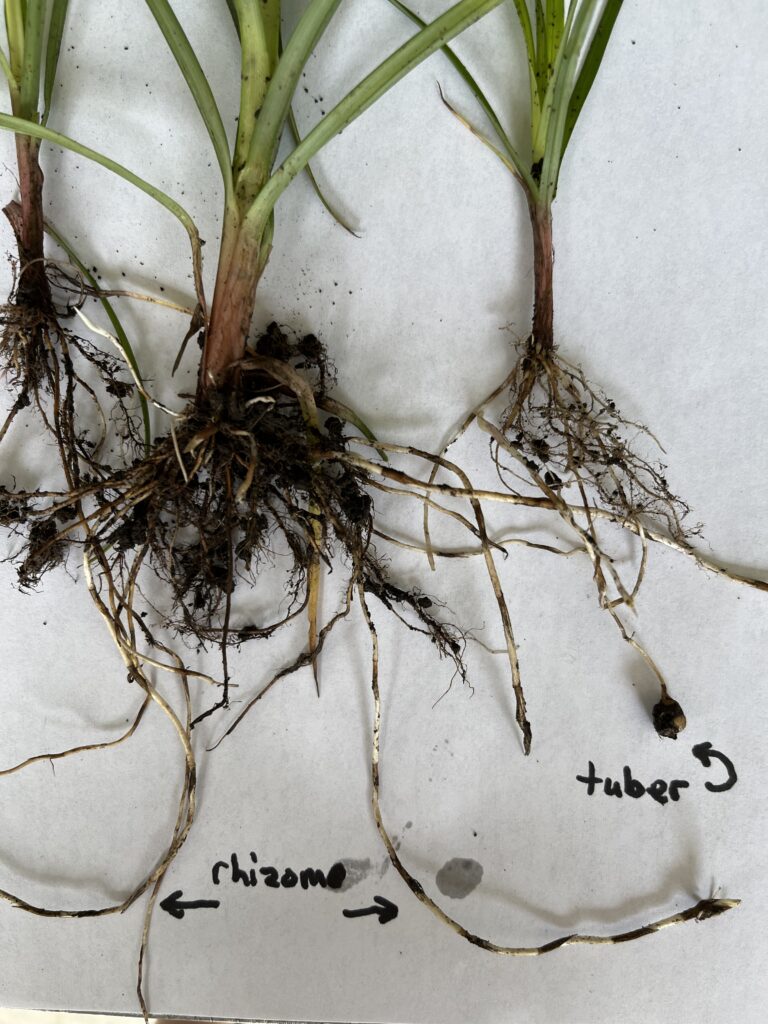This time of year, yellow nutsedge (Cyperus esculentus) and purple nutsedge (Cyperus rotundus) become problematic in the landscape. These problem weeds have triangular grass-like leaves and form colonies if left unchecked. It is not a grass, but rather a sedge. The key identifying feature is the triangular stem in cross section, as opposed to a round cross section in grasses.
In Lawns
Nutsedge is a common weed in lawns with waterlogged soil, and its presence often indicates that drainage is poor, irrigation is too frequent, or sprinklers are leaky. Once established, however, it will tolerate normal irrigation conditions or drought. Established nutsedge plants grow faster than many lawn grasses, so it is often noticed when it outgrows the surrounding grass. The leaves are bright green and have a waxy appearance in summer when surrounding lawn grass may be a lighter green.
Management in Lawns
As with most weeds in lawns, the best defense is to maintain a healthy, dense turf that can compete and prevent weed establishment. Water lawns on an as-needed basis, not on a regular schedule. Overwatering increases disease and provides a better environment for nutsedge to grow.
For larger infestations in lawns, spot spray with a liquid, selective herbicide that contains the active ingredient: Common Name: Halosulfuron; Trade Name: Manage, or Sedgehammer and others or Common Name: Sulfentrazone. Mixing these herbicides with a non-ionic surfactant that breaks down the waxy leaf coating to the chemical is more effective.
In Mulch
Nutsedges thrive in areas with little or no competition. In mulch rings around trees and between flowers offer ideal conditions for large colonies to form. Actively growing stands of nutsedge have extensive root systems that can reach as deep as four feet. Nutsedges produce underground tubers and runners that make it difficult to pull out of the ground. Each of these can produce another plant if not completely removed.
Mechanical management
Digging out or using an appropriate weeding tool to remove the underground ‘nutlets’ is the primary means of mechanical control of nutsedge. This is a viable option at the beginning of an infestation and on young weeds. If you want to avoid spraying chemicals for control of nutsedge, you need to relentlessly pull the plants every time a new plant emerges. It is most active in May through October. We have also smothered nutsedge with cardboard and two to four inches of mulch. Nutsedge may emerge again next year after the cardboard has decomposed.

Spraying
We have had success spraying nutsedge. We use Manage™ (Sledgehammer) herbicide. It is a selective herbicide that only kills nutsedge and can be sprayed in close proximity to other perennials, shrubs and trees. It takes a few weeks for the plants to show decline, but Manage™ kills the whole plant including the runners and tubers. I have used Roundup as a control, but it is a non-selective contact herbicide that kills the weeds it contacts.
Nutsedges are often unwelcome competition for our more desirable plants. These “weeds” can be controlled by a healthy, actively growing landscape. Competition and vigorous plantings will push these plants aside. If you do find it in your landscape, remove it immediately. If you have larger areas, be persistent, over time, you will get the upper hand. Be as unrelenting as the weeds. As they say on the Red Green Show, “We are all in this together. I am pulling for you.”





